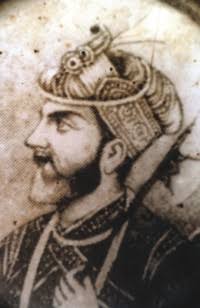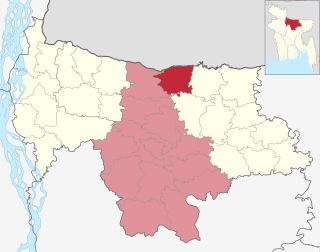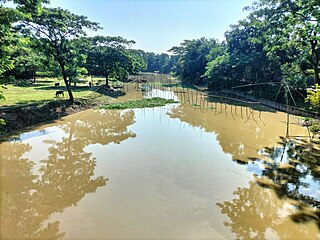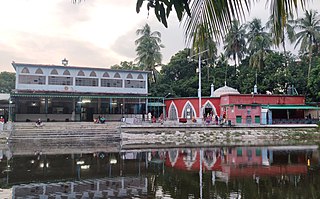Related Research Articles

The music of Bangladesh spans a wide variety of styles. Bangladesh claims some of the most renowned singers, composers and producers in Asia. Music has served the purpose of documenting the lives of the people and was widely patronized by the rulers. It comprises a long tradition of religious and regular song-writing over a period of almost a millennium.

Dhaka Division is an administrative division within Bangladesh. Dhaka serves as the capital city of the Dhaka Division, the Dhaka District and Bangladesh. The division remains a population magnet, covers an area of 20,508.8 km2 with a population in excess of 44 million, It is the most populous country second level division of the world, growing at 1.94% rate since prior count, compared with national average of 1.22%. However, national figures may include data skewing expatriation of male labor force as gender ratio is skewed towards females.

Islam is the largest and the state religion of the People's Republic of Bangladesh. According to the 2022 census, Bangladesh had a population of about 150 million Muslims, or 91.04% of its total population of 165 million. The majority of Bangladeshis are Sunni, and follow the Hanafi school of fiqh. Despite being a secular state, Bangladesh is a de facto Islamic country.

Isa Khan was the leader of the 16th-century Baro-Bhuiyan chieftains of Bengal. During his reign, he successfully unified the chieftains of Bengal and resisted the Mughal invasion of Bengal. It was only after his death that the region fell totally under Mughal control. He remains an iconic figure throughout West Bengal and Bangladesh as a symbol of his rebellious spirit and unity.

Mymensingh District is a district in Mymensingh Division, Bangladesh, and is bordered on the north by Meghalaya, a state of India and the Garo Hills, on the south by Gazipur District, on the east by the districts of Netrokona and Kishoreganj, and on the west by the districts of Sherpur, Jamalpur and Tangail. Mymensingh is the 8th administrative divisional headquarter and 12th city corporation of Bangladesh. According to Ministry of Public Administration, Mymensingh is ranked 4th in district status. The density of Mymensingh city is 44,458/km2 which is the second most densely populated city in Bangladesh. Mymensingh attracts 25 percent of health tourists visiting Bangladesh. Once known as the largest district of the Indian subcontinent. Mymensingh town is the district headquarters.

Netrokona is a district of the Mymensingh Division in northern Bangladesh.

Sherpur district is a district in Northern Bangladesh. It is a part of Mymensingh Division. Sherpur district was a sub-division of Jamalpur District before 1984. It was upgraded to a district on February 22, 1984. Sherpur City is located about 197–199 kilometres (122–124 mi) north of Dhaka, capital of Bangladesh.
Majnu Shah or Faqir Majnu Shah Burhan was a faqir from the present-day Uttar Pradesh, who actively participated in the Fakir-Sannyasi Rebellion, which, according to a number of scholars, was an early war for India's independence and joined in many battles against the British East India Company with his 'pious team'.

The Baro-Bhuyans were confederacies of soldier-landowners in Assam and Bengal in the late Middle Ages and the early modern period. The confederacies consisted of loosely independent entities, each led by a warrior chief or a landlord. The tradition of Baro-Bhuyan is peculiar to both Assam and Bengal and differ from the tradition of Bhuinhar of Uttar Pradesh and Bihar—in Assam this phenomenon came into prominence in the 13th century when they resisted the invasion of Ghiyasuddin Iwaj Shah and in Bengal when they resisted Mughal rule in the 16th century.

Dhobaura is an upazila of the Mymensingh District in Bangladesh.

Netrokona Sadar is an upazila (sub-district) of Netrokona District under Mymensingh Division, Bangladesh.

The national language and official language of Bangladesh is Bangla according to the third article of the Constitution of Bangladesh. Almost 99% of Bangladeshis speak Bengali as their first language. Bengali Language Implementation Act, 1987 made it mandatory to use Bengali in all government affairs except in the cases of foreign relations. According to a 2022 census, Bengali is predominantly spoken by 99% of the country's population and it also serves as the national language of the nation. The indigenous people of northern and southeastern Bangladesh speak a variety of native languages. According to the Ethnologue, there are 36 indigenous living languages, which include 17 Tibeto-Burman, 10 Indo-Aryan, 7 Austroasiatic and 2 Dravidian languages in Bangladesh. Bangladesh has 44 indigenous languages according to Professor Shameem Reza.
Karim Shah, also known as Karam Shah, was the founder of the mystic Pagal Panthi order in eastern Bengal.
Tipu Shah was the second leader of the mystic Pagal Panthi Order in Mymensingh. He commanded the Order and the local peasantry in revolts against the British East India Company and managed to establish an independent state in Sherpur.
The Tanka movement was a militant agrarian struggle on behalf of the Hajong tribal people in Mymensingh District, British Bengal 1937–1950. The movement was parallel, but distinct from, the Tebhaga movement in other parts of Bengal. The Hajong movement was inspired by the struggles of Moni Singh.

The Hajong people are an ethnic group from Northeast India and northern parts of Bangladesh. The majority of the Hajongs are settled in India and are predominantly rice-farmers. They are said to have brought wet-field cultivation to Garo Hills, where the Garo people used slash and burn method of agriculture. Hajong have the status of a Scheduled Tribe in India and they are the fourth largest tribal ethnicity in the Indian state of Meghalaya.

Shah Inayatullah, popularly known as Sufi Shah Inayat Shaheed, Shah Shaheed or Shah Inayat of Jhok, was a 17th-century Sindhi Sufi saint and revolutionary from Jhok. He was the first socialist and agricultural reformist of Sindh.

Ahmadiyya is a minority religion in Bangladesh. Although the first Bengalis to join the religion did covert during the lifetime of Mirza Ghulam Ahmad, the religion was first established as a community in the region of Bengal in 1913 by Syed Muhammad Abdul Wahed, during the Caliphate of Hakeem Noor-ud-Din. As the worldwide community is itself is an highly organised group under the Caliph, the national community works under the name Ahmadiyya Muslim Community Bangladesh or Ahmadiyya Muslim Jama'at Bangladesh. There are an estimated 100,000 Ahmadis in the country as of 2004.

Gulamur Rahman Maizbhandari, also known by his sobriquet Baba Bhandari, was a Bengali Sufi preacher who succeeded his uncle, Syed Ahmad Ullah, as the head of the Maizbhandari Sufi Order, the first such Sufi order in Bengal.

‘Abd al-Quddūs Jalāl ad-Dīn, best known as Shah Makhdum, and also known as Rupos, was a Sufi Muslim figure in Bangladesh. He is associated with the spread of Islam into the Varendra region of Bengal. He arrived in Bengal with his elder brother Syed Ahmad from Baghdad. Shah Makhdum Airport of Rajshahi, is named after him.
References
- 1 2 3 4 5 6 7 Hussain, M Delwar (2012). "Pagal Panthi Movement". In Islam, Sirajul; Jamal, Ahmed A. (eds.). Banglapedia: National Encyclopedia of Bangladesh (Second ed.). Asiatic Society of Bangladesh.
- 1 2 3 Hussain, M Delwar (2012). "Tipu Shah". In Islam, Sirajul; Jamal, Ahmed A. (eds.). Banglapedia: National Encyclopedia of Bangladesh (Second ed.). Asiatic Society of Bangladesh.
- ↑ Khan, Muazzam Hussain (2012). "Majnu Shah". In Islam, Sirajul; Jamal, Ahmed A. (eds.). Banglapedia: National Encyclopedia of Bangladesh (Second ed.). Asiatic Society of Bangladesh.